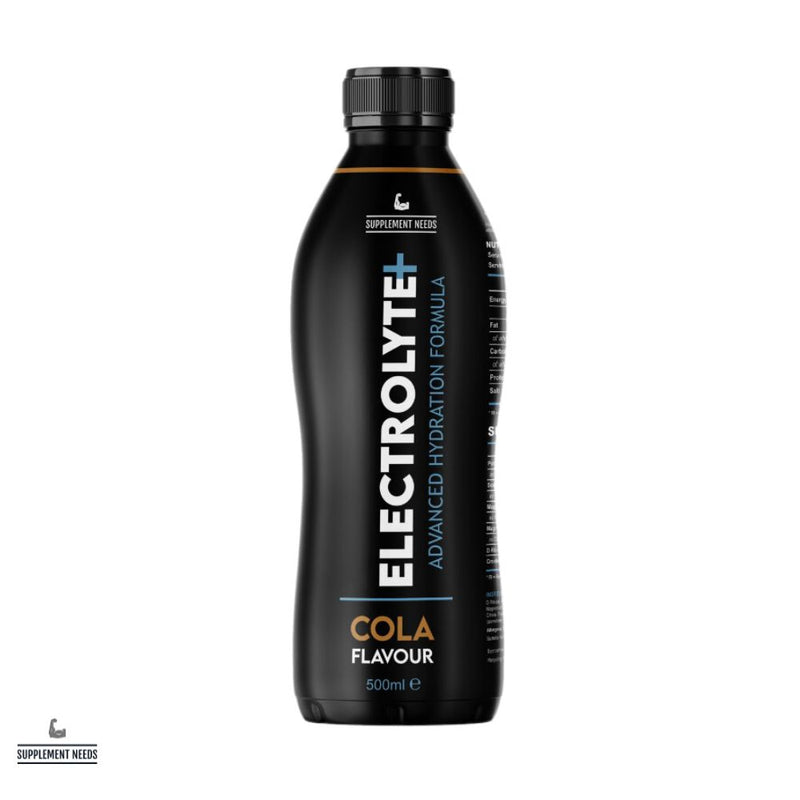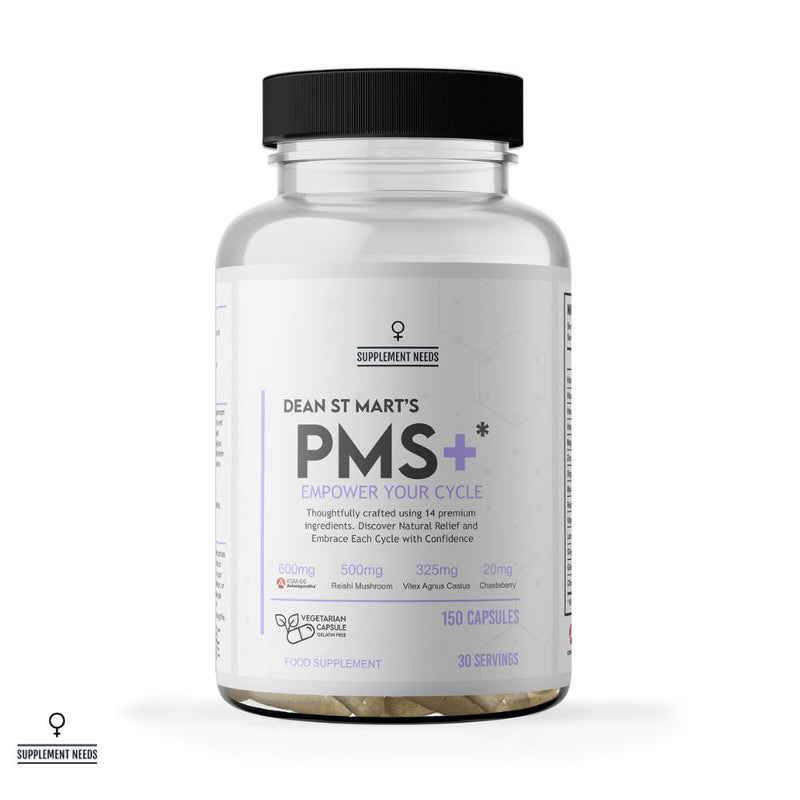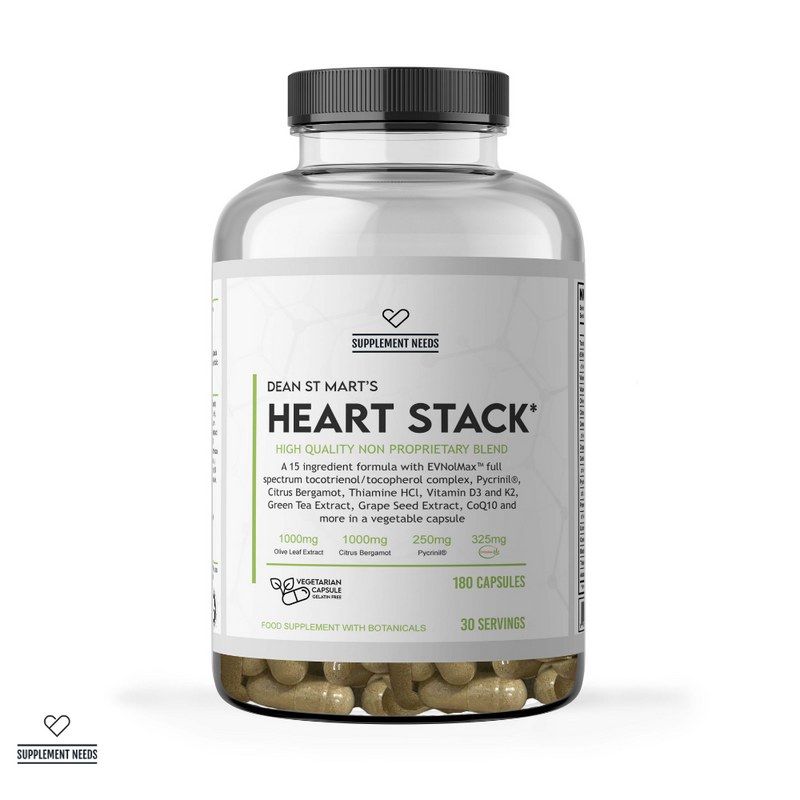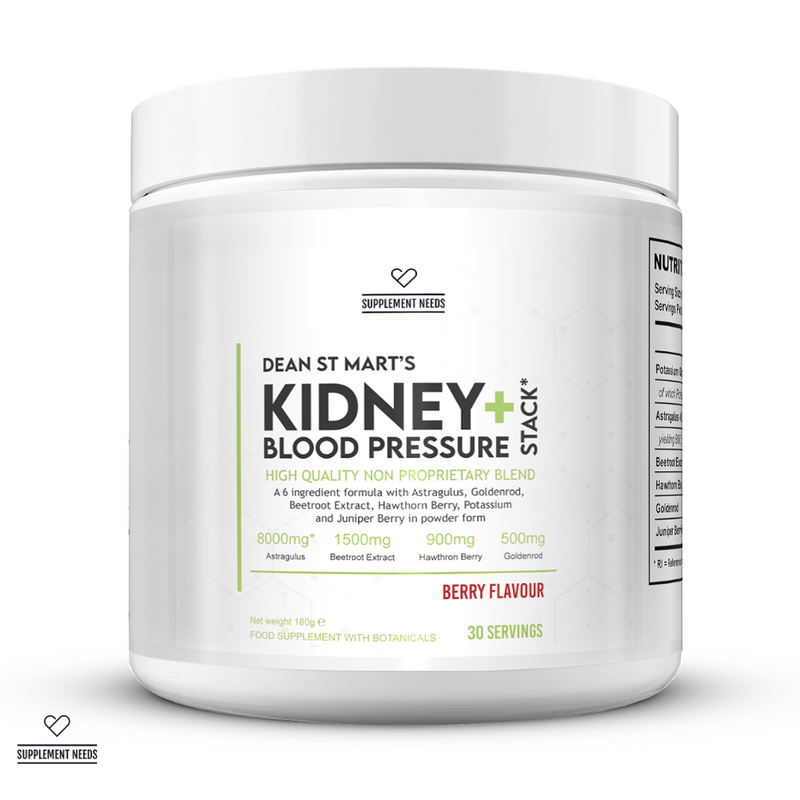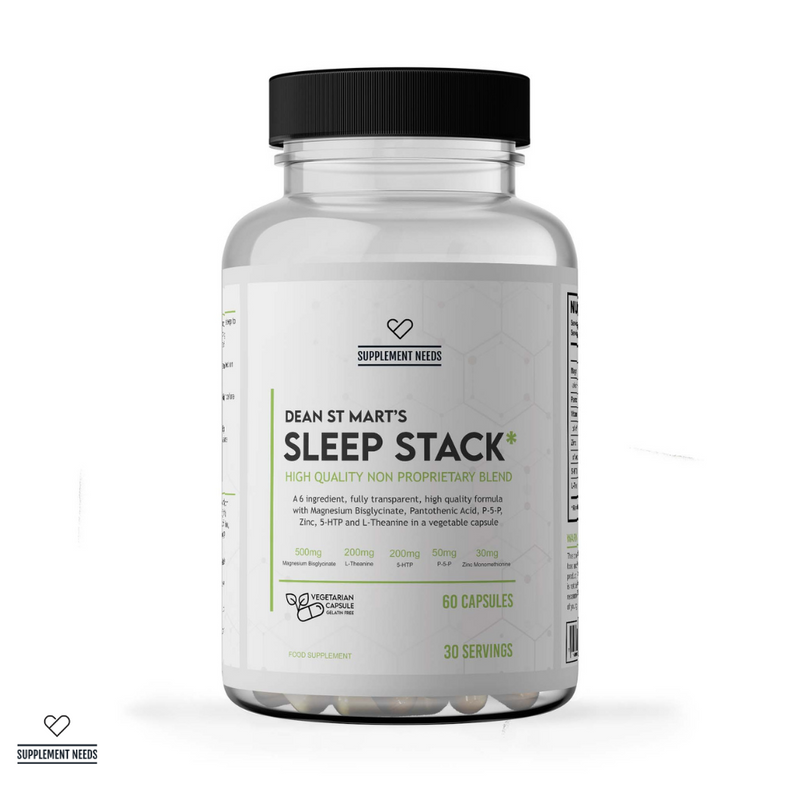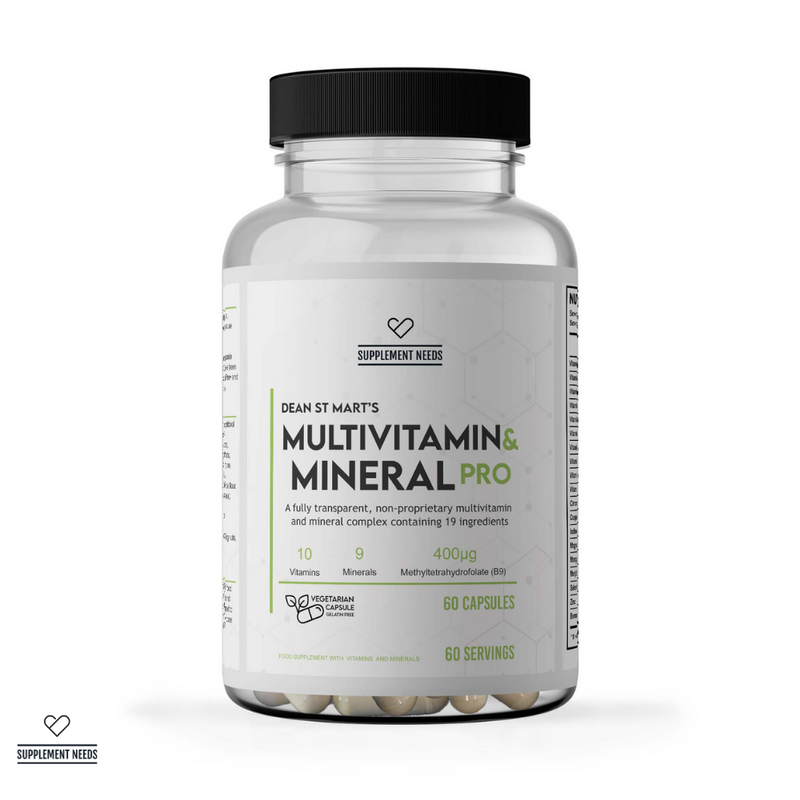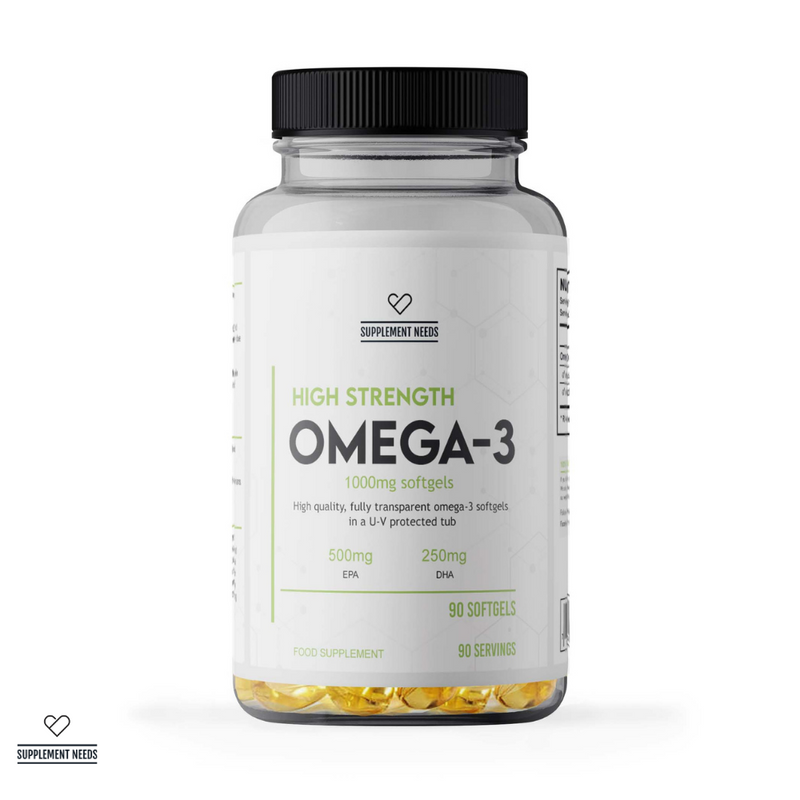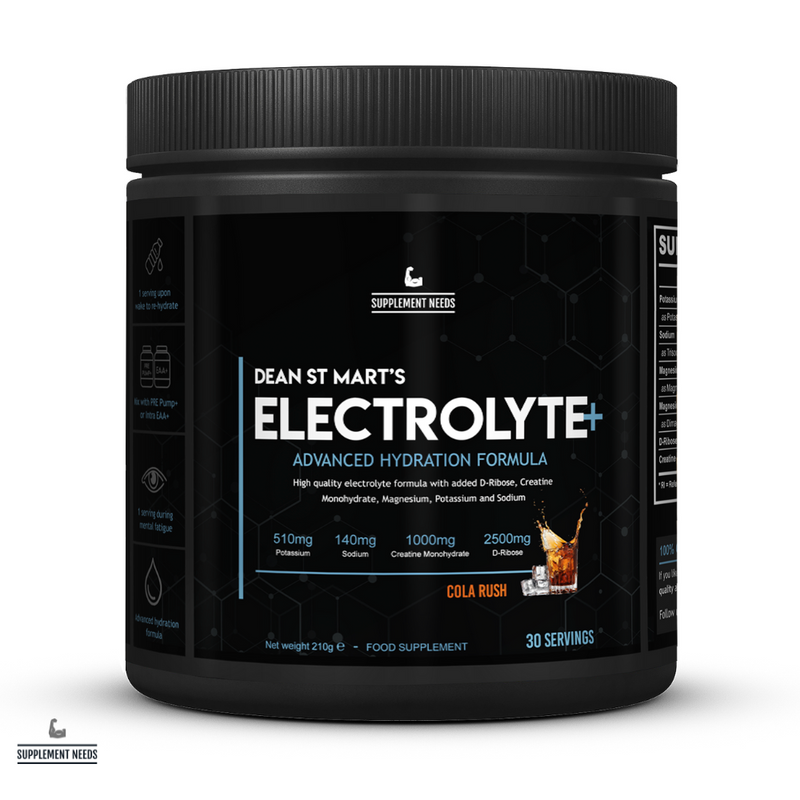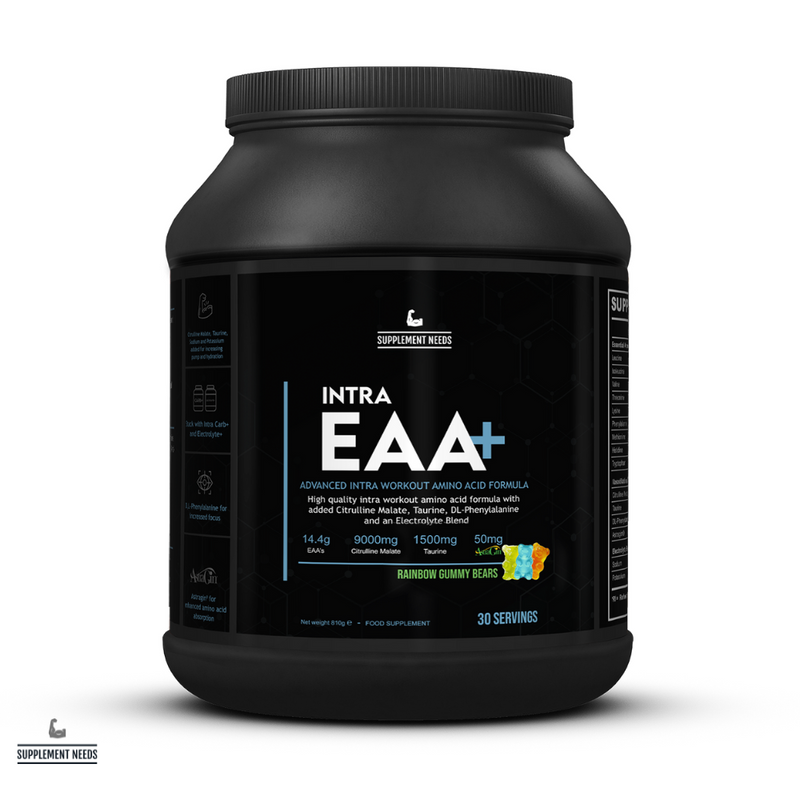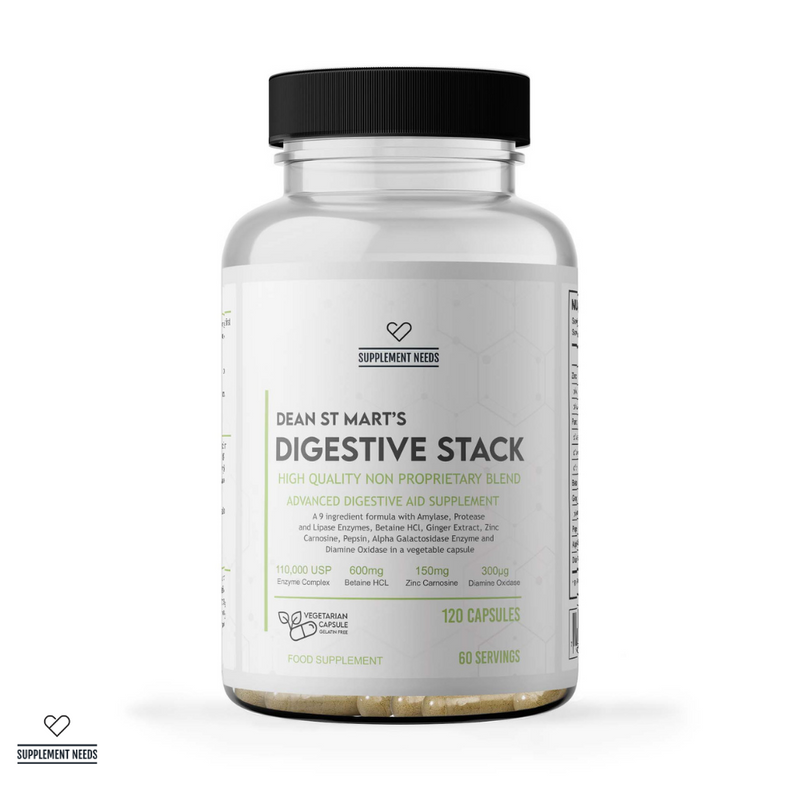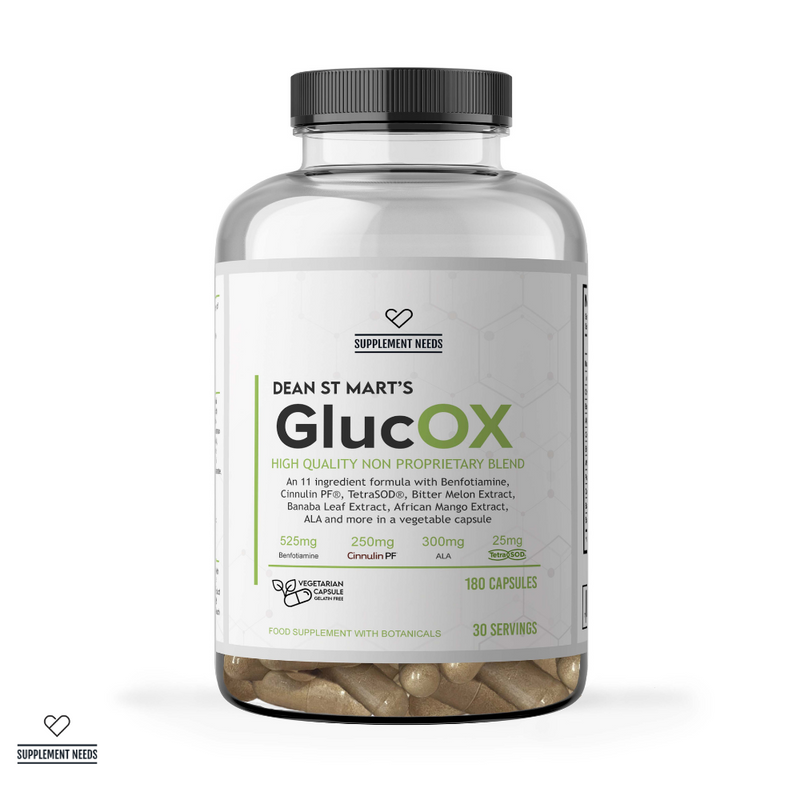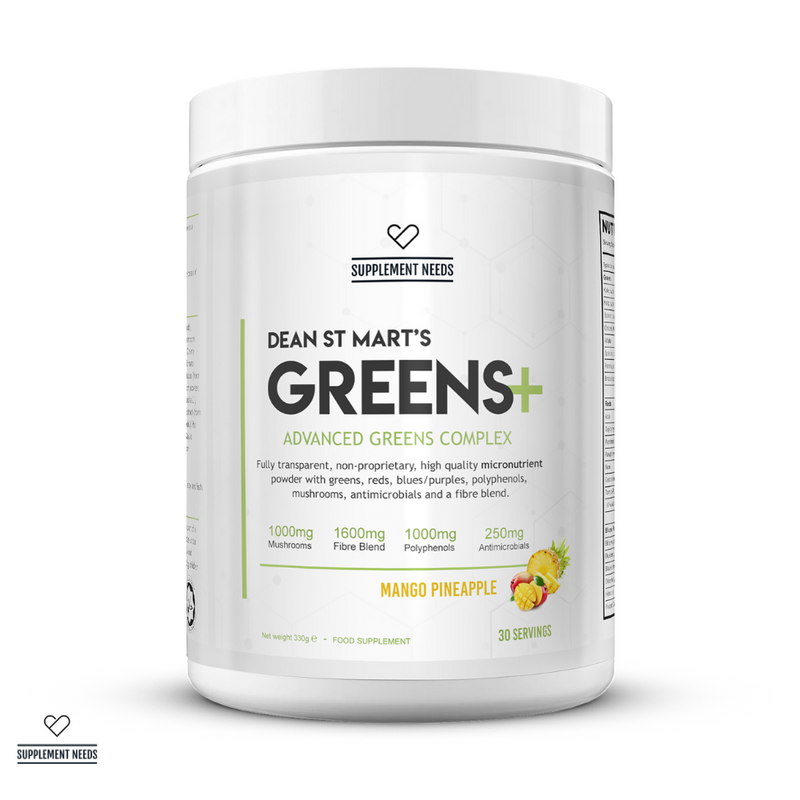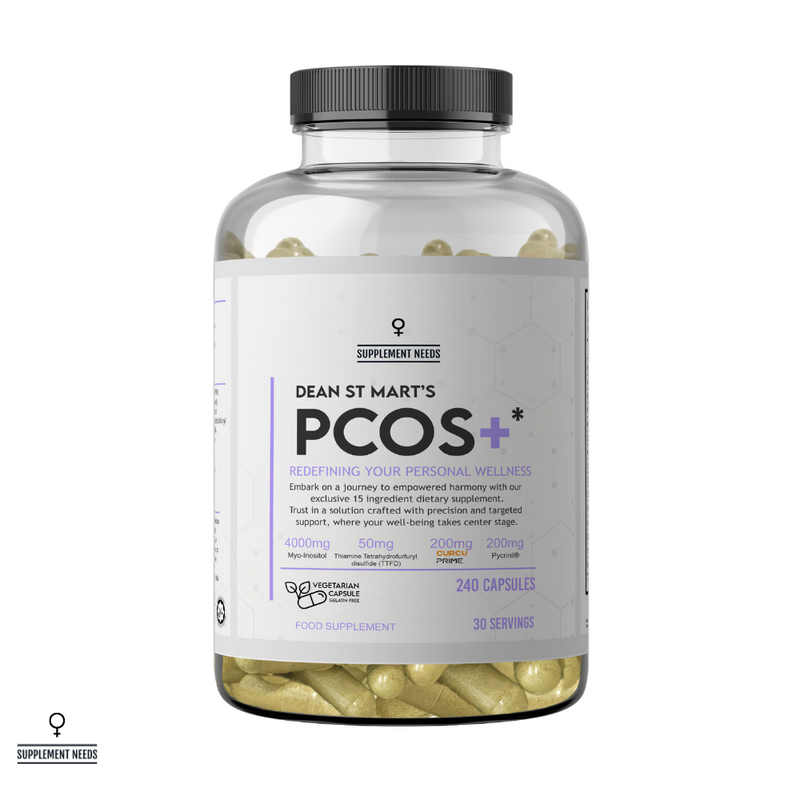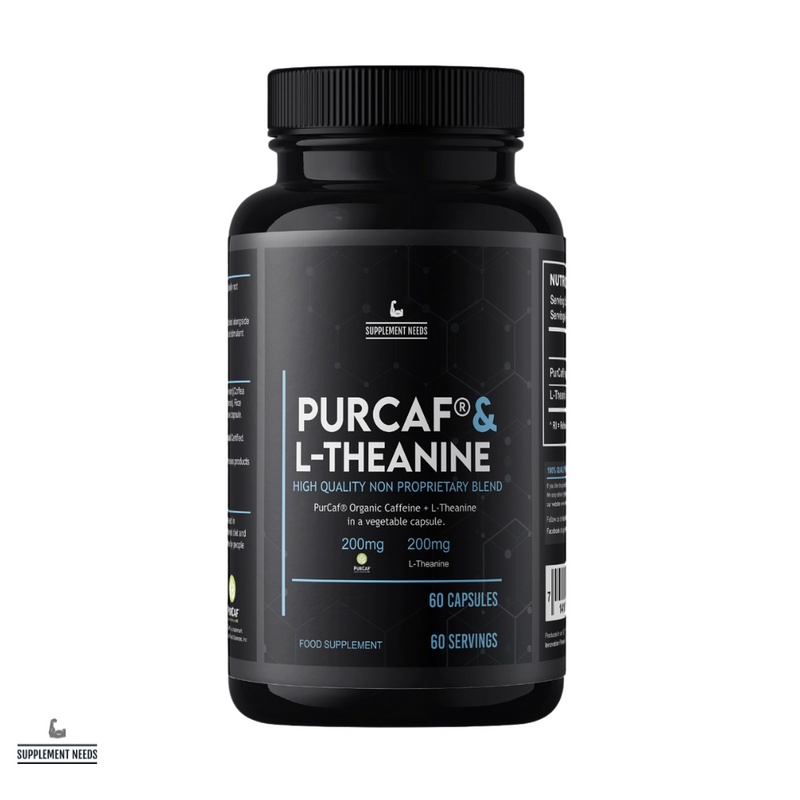Joint pain can be one of the most acute, unpleasant forms of pain you can experience. So, it makes sense to try and avoid developing joint pain in the first place. For some people, this involves supplementing their diet with Glucosamine. But, what exactly is Glucosamine? Is there evidence to show its effectiveness? Let’s take a look…
What is Glucosamine?
You only have to turn on the television to see adverts for Glucosamine. For decades, it’s been a popular supplement to support joint health.
It’s also regularly mated with something called Chondroitin.
But, what exactly is Glucosamine?
In the simplest terms, Glucosamine is an amino sugar1 (a sugar molecule in which a hydroxyl group has been replaced with an amine group). It occurs endogenously within the body as glucosamine-6-phosphate and is synthesised within the first step of the hexosamine biosynthesis pathway2.
Glucosamine itself is also a precursor in the biochemical synthesis of other molecules, including glycosylated proteins and lipids.
In addition to that, it also plays an important structural role in chitosan and chitin - two polysaccharides that perform various roles within the body. In this way we can see that Glucosamine3 is a precursor agent to glycosaminoglycans - which are a major component of cartilage. As one study characterises glycosaminoglycans, ‘Historically, the function of GAGs was thought to be limited to cell hydration and structural scaffolding’4.
We appreciate that’s a fairly technical explanation of Glucosamine. So, what does it do in simpler terms?
Glucosamine - which can be synthesised by your body, but also obtained from external dietary sources - is used by the body to create glycosaminoglycans. These, in turn, are used within the structure of cartilage.
When it comes to buying Glucosamine ‘off-the-shelf’, you’ll find that the majority of Glucosamine supplements take the form of Glucosamine Sulphate, Glucosamine Hydrochloride, or N-Acetyl Glucosamine.
These forms of Glucosamine are usually sourced from either shellfish or manufactured in a laboratory.
Note - here at Supplement Needs our Glucosamine & Chondroitin has been formulated to include Glucosamine Sulphate 2KCI (at 500 mg per 1 capsule serving). Of this, 296 mg is Glucosamine. This type of Glucosamine is made via the hydrolysis of shellfish skeletons. If you’re wondering what the 2KCI stands for, this is simply potassium chloride which is used to stabilise the Glucosamine.

What is Chondroitin?
Another name that crops up when it comes to talk about joint health is Chondroitin.
Chondroitin is a naturally-occurring molecule that is produced endogenously within the human body. It is one of the glycosaminoglycans that Glucosamine is a precursor of (in other words, Glucosamine is synthesised by the body first, and is then used to produce Chondroitin at a later stage)5.
In particular, Chondroitin Sulphate is ‘one of the natural glycosaminoglycans (GAG) composed of the alternating sugars D-glucuronic acid (GlcA) and N-acetyl-D-galactosamine (GalNAc). It is an important component of the extracellular matrix (ECM)’6.
So, what’s the main functional role of Chondroitin within the body? The answer is that it’s the main component within cartilage.
Chondroitin’s role has been identified as being responsible for water retention within cartilage, which helps to maintain pressure resistance
Chondroitin does this by helping to form proteoglycans7 - which attract water and contribute to the cartilage’s elasticity and ability to withstand shocks (e.g. such as when you are engaged in an activity like running).
Chondroitin also supports cartilage by helping to protect chondrocytes - cells that are responsible for maintaining the structure of the cartilage (as well as the extracellular matrix more widely)8.
Chondroitin takes two forms:
-
Chondroitin Sulphate.
-
Dermatan Sulphate.
Chondroitin Sulphate is - as the name suggests - a sulphated glycosaminoglycan (GAG) that is composed of a chain of alternating sugars (N-acetylgalactosamine and glucuronic acid).
Dermatan Sulphate is also a glycosaminoglycan (GAG) and is composed of linear polymers of disaccharide units that contain N-acetyl galactosamine (GaINAc) and iduronic acid (IdoA). Until recently Dermatan Sulphate was known as Chondroitin Sulphate B - although this has fallen out of common usage9.
Note - there are, in fact, a number of different ‘types’ of Chondroitin Sulphate based on their fraction of sulphation. The table below sets out a taxonomic overview of Chondroitin Sulphate based on their ‘letter identification’:
|
Letter Identification |
Site of Sulphation |
Systematic Name |
|
Chondroitin Sulphate A |
Carbon 4 of the N-acetylgalactosamine (GaINAc) sugar |
Chondroitin-4-Sulphate |
|
Chondroitin Sulphate C |
Carbon 6 of the GaINAc sugar |
Chondroitin-6-Sulphate |
|
Chondroitin Sulphate D |
Carbon 2 of the glucuronic acid and 6 of the GaINAc sugar |
Chondroitin-2,6-Sulphate |
|
Chondroitin Sulphate E |
Carbons 4 and 6 of the GaINAc sugar |
Chondroitin-4,6-Sulphate |
Like Glucosamine, dietary Chondroitin (i.e. the Chondroitin you find in supplements) is derived from either animal or lab-based sources. In animal-based instances, the Chondroitin is extracted directly from the cartilage of the animal. In lab-based instances, Chondroitin is typically produced via chemical, enzymatic or even microbial fermentation methodologies10.
Glucosamine and chondroitin: a partnership
As you’ve read so far, Glucosamine and Chondroitin are - in a sense - inextricably linked. After all, Glucosamine is a precursor to Chondroitin - and both are integral to the composition and function of cartilage (and by extension, broader joint health).
That’s why you’ll often see the two combined in supplements.
Here at Supplement Needs, we’ve done exactly that with our Supplement Needs Glucosamine & Chondroitin supplement.
In the next section, we’ll examine the evidence base for both Glucosamine and Chondroitin’s effectiveness.
The potential benefits of Glucosamine
Let’s begin by looking at the potential health benefits that have been associated in studies with Glucosamine.
May reduce inflammation
One of the most widely and acutely studied aspects of Glucosamine is its role in potentially reducing inflammation.
As we’ve written about numerous times here at Supplement Needs, inflammation - especially on a chronic basis - can adversely affect myriad organs, parts and bodily systems. If persistent, inflammation can even lead to the development of chronic diseases.
So, how can Glucosamine potentially prevent or reduce inflammation?
A two-year cohort study that concluded in 2016 found that participants who took 1,500 mg of crystalline glucosamine on a daily basis resulted in a 36% reduction in nonsteroidal anti-inflammatory drug (NSAID) use. The study’s authors concluded that Glucosamine could help to inhibit or reduce inflammation due to its ability to inhibit the expression and/or activity of catabolic enzymes such as phospholipase A2, matrix metalloproteinases, or aggrecanases11.
A separate study has also indicated that Glucosamine exerts anti-inflammatory activities - primarily by inhibiting the NLRP3 inflammasome12 (an inflammasome being a multi-protein complex that, when activated, triggers a cascade of inflammatory responses).
Support healthy joints
As we saw earlier, Glucosamine plays an integral role in articular cartilage - which is in effect a smooth white tissue that covers the end of your joints. Not only does cartilage act as a shock absorber, but it helps your bones glide smoothly over one another13.
In short, cartilage is important!
The cartilage in your joints is also assisted by something known as synovial fluid. This acts as a form of lubrication to assist in the smooth movement of your joints.
And, guess what? Glucosamine has been linked with the formation of synovial fluid. As one study postulates, Glucosamine increases the production of hyaluronic acid14, which in turn is a key part of synovial fluid.
In short, Glucosamine helps to create those chemical compounds that are used to create cartilage and synovial fluid - thus contributing to the healthy function of your joints.
Another interesting point that has arisen around Glucosamine is its seeming ability to inhibit cartilage breakdown. A 2019 study15 of collegiate soccer players found that taking 1.5 to 3 grams of Glucosamine daily for three months decreased cartilage breakdown. To quote the study directly, ‘Glucosamine demonstrates a chondroprotective action on these athletes by preventing type II collagen degradation but maintaining type II collagen synthesis’.

May support the symptoms of bone and joint disorders
Glucosamine has been well studied for its potential to help treat the symptoms and disease progression of bone and joint disorders such as osteoarthritis (OA) and rheumatoid arthritis (RA).
The overall picture of Glucosamine in relation to these disorders appears to be mixed.
A number of studies have come to the conclusion that Glucosamine supplementation does have at least some therapeutic value.
Veronese et al. concluded in 202016 that ‘GS, when used as a prescription drug (i.e. crystalline glucosamine sulphate) at 1,500 mg daily dosage, can positively affect the cartilage structure, reduce pain, improve function and glucose metabolism in people with knee OA, without having a greater incidence of adverse effects than placebo’.
Yet, conversely, a group of other studies have not found Glucosamine supplementation to significantly improve joint pain or function in certain joint conditions. Yet, even these studies do have some beneficial effects related to Glucosamine. Knapik et al. noted that, ‘GS may have a small to moderate effect in reducing OA-related pain but little effect on joint-space narrowing’17.
In short - the jury is still out on Glucosamine and its potential to help with joint-related disorders. Expect a battery of more studies to be cresting the horizon soon!
The other potential benefits of Glucosamine
Although the majority of the scientific study of Glucosamine has focused on how it can support joint health, it is in fact regularly used in relation to a number of health conditions. These include:
-
Interstitial cystitis: Glucosamine has been pointed to as a way of potentially treating interstitial cystitis. Why? Because, interstitial cystitis is commonly as a result of a deficiency in glycosaminoglycan. As Glucosamine is a precursor agent to glycosaminoglycan, scientists have speculated that supplementation of Glucosamine could, in turn, help manage interstitial cystitis18.
-
Inflammatory bowel disease: although the evidence is tentative and confined largely to animal studies, there is some limited evidence to suggest that Glucosamine supplementation may help with the symptoms of inflammatory bowel disease (IBD). A study in mice with IBD who were given n-acetylglucosamine appeared to show a reduction in inflammatory markers19.
-
Temporomandibular joint disorders: again, although there is a limited evidence base, there are a handful of studies that indicate that Glucosamine may be an effective therapy for temporomandibular joint disorders (that is, problems with jaw pain). A small study demonstrated a reduction in pain and inflammatory markers as well as increased jaw mobility in participants who had received a daily supplement combining Glucosamine and Chondroitin20.
The potential benefits of Chondroitin
As we saw earlier, because Glucosamine is the precursor to Chondroitin, the two molecules work together as a perfect partnership.
So, it’s only natural that scientists have extended their studies to Chondroitin and the many potential benefits it could have for human health.
In isolation, Chondroitin has mostly been studied for its potential to help manage the symptoms of osteoarthritis.
Take a 2017 double-blind, randomised study21 that involved 604 participants who had knee osteoarthritis. The study compared the effectiveness of taking 800 mg per day of Chondroitin sulphate, 200 mg of celecoxib (a popular nonsteroidal anti-inflammatory drug), and a placebo.
After six months, the Chondroitin sulphate resulted in similar pain scores to celecoxib, and superior pain scores compared to the placebo group. The study’s authors concluded that: ‘A 800 mg/day pharmaceutical-grade CS is superior to placebo and similar to celecoxib in reducing pain and improving function over six months in symptomatic knee osteoarthritis (OA) patients. This formulation of CS should be considered a first-line treatment in the medical management of knee OA’.
The importance of joint health
By now, you’ve hopefully gained a good understanding of Glucosamine, Chondroitin, and the potential benefits that may provide to your body.
However, let’s take a closer look at the concept of joint health itself.
What are joints?
A joint can be defined as a part of the body where two or more bones connect. Within the body, there are three types of joints22. These are:
-
Synovial joints: these are the joints in your body that provide the greatest degree of movement. Your elbows, hips and knees are examples of synovial joints.
-
Cartilaginous joints: these are joints which are only able to move a little. They in effect ‘flex’ and are found in your spine.
-
Fibrous joints: these are joints that were able to move when you were born, but which subsequently fused together as you matured. These fibrous joints are found in the skull.
What do joints consist of?
So, we know that joints involve the meeting of two or more bones. But, what are they actually composed of?
Your joints are effectively composed of a series of tissues that interact with each other. These tissues include:
-
Ligaments: which are used to hold the bones at the joint together. Ligaments are tough, fibrous bands of connective tissue which provide considerable stability to your body. They consist of collagen, elastin, fibroblasts, proteoglycans, and water.
-
Tendons: it’s the job of tendons to attach muscles to bones and control the overall movement of the joint. Tendons have a similar composition as ligaments, consisting of collagen, elastin, tenocytes, proteoglycans, and water.
-
Cartilage: this is a tissue which covers the surface of a bone at a joint. It’s the job of cartilage to reduce friction and reduce wear on the bones themselves. As we saw earlier, cartilage is made from chondrocytes and an extracellular matrix that is rich in collagen.
-
Bursae: these are fluid-filled pods that sit within the joint and effectively act as cushions where bones meet. They are composed of synovial membranes and synovial fluid.
What is cartilage?
One of the most common questions when it comes to joints is ‘what is cartilage?’
Most people have heard about cartilage in relation to athletes and sports people as damage to cartilage is a common injury.
But, what exactly is it?
Scientists define it as ‘A tough, flexible tissue that lines joints and gives structure to the nose, ears, larynx, and other parts of the body’23.
What we’re interested in, in this article, is ‘other parts of the body’ - in particular, joints.
As we mentioned earlier, cartilage in relation to joints is the material that stops direct bone-on-bone contact.

How does cartilage become damaged?
If it’s so important, how does cartilage actually become damaged? Well, there are a number of ways in which cartilage can be damaged:
-
In an acute sense e.g. a sport injury. Sudden impacts and excessive twisting of joints are two of the most common ways in which cartilage can be damaged.
-
Overuse and repetitive impacts can degrade cartilage in your joints over time.
-
Ageing. Cartilage does, unfortunately, wear away over time and - when progressed for long enough can develop into osteoarthritis.
Can cartilage grow back?
If you have experienced cartilage damage yourself, this is probably one of the first questions you’ve asked your doctor.
The reality is that it’s quite difficult for your cartilage to ‘grow back’ naturally. However, this hasn’t stopped scientists from researching the topic in-depth.
For example, one study conducted in early 2023 investigated strategies for cartilage regeneration. The researchers conducted a narrative literature review of studies that involved non-FDA approved IA injections for the treatment of primary osteoarthritis of the knee.
The team concluded that certain IA injections could potentially improve cartilage health. Specifically, they identified a suite of approaches that could work: ‘It is clear that the most promising IA injections that could improve treatment of primary OA are bioengineered advanced-delivery steroid-hydrogel preparations, ex vivo expanded allogeneic stem cell injections, genetically engineered chondrocyte injections, recombinant fibroblast growth factor therapy, injections of selective proteinase inhibitors, senolytic therapy via injections, injectable antioxidant therapies, injections of Wnt pathway inhibitors, injections of nuclear factor-kappa β inhibitors, injections of modified human angiopoietin-like-3, various potential viral vector-based genetic therapy approaches, and RNA genetic technology administered via injections’24.
How futuristic!
Other studies have looked at the nascent field of ‘cartilage engineering’. However, despite rapid advances, and early results being promising, ‘engineered cartilage with properties identical to those of native cartilage is currently unavailable’.
Researchers have highlighted that ‘significant obstacles remain’, and that ‘Regulatory hurdles, as well as safety, viability, and potential immunogenicity of the engineered tissue are all outstanding challenges’25.
In summary, the prospect of being able to ‘regenerate’ cartilage seems distant. Thus, it makes sense to be proactive in managing your joint health and preventing the early degradation of your cartilage in the first place.
How can you keep your joints healthy?
Your joints are complex mechanisms, with multiple interacting surfaces. Failure to look after your joints can lead to limited mobility, chronic health conditions and more in later life.
If you want to maintain the health of your joints, there are a number of actions you can take which we have set out below.
Engage in regular physical activity
Engaging in a range of physical activities including strength training, aerobic exercise and flexibility exercises can all help support the health of your joints.
In addition to exercise, it’s well worth ensuring you are generally active throughout the day - take the stairs rather than a lift, walk rather than drive short distances etc. All these things will help maintain the strength and condition of your joints.
According to the Arthritis Foundation26, physical activity stimulates the production of synovial fluid which - as we saw earlier - essentially acts as a ‘lubricant’ for your joints, reducing wear and keeping them healthy.
The Arthritis Foundation also states that ‘exercise strengthens the muscles, ligaments, and tendons surrounding the joints. When these tissues are strong, they act like a brace to protect the joint”27.
In short - one of the best ways you can support and protect the health of your joints is to engage in regular exercise. Perhaps the time is right to join a gym (if you haven’t already)?
Note: it is also important to ensure you exercise using the proper form and to ‘listen’ to your body. If something doesn’t feel right, then don’t persist with exercise. You could end up injuring your joints!
Maintain a healthy weight
A significant preventative measure you can take to protect your joint health is to maintain a healthy weight.
Why? Because a preponderance of studies present a strong link between being overweight or obese and suffering from poor joint and bone health. One 2012 study28 concluded that ‘the odds of arthritis and OA was up to 7 times higher for obese individuals, compared with those classified as underweight/normal weight. Concurrent obesity and joint disease had a marked impact on several key aspects of wellbeing, highlighting the need for public health interventions’.
Other studies reinforce this view. Reyes et al.29 found ‘a positive association between overweight and obesity with the risk of developing OA at the knee, hip, and hand. The excess risk found was greater for subjects with grade II obesity, who were 4.7 times more likely to develop knee OA compared to subjects with normal-weight’.
It seems then, that one of the best things you can do to maintain the health of your joints, is to maintain a healthy weight.

Nourish your joints
Your bones and joints all require essential vitamins and minerals for maintenance purposes - so, it’s important your body isn’t deficient in any of these things.
In addition to maintaining a healthy diet you may also consider supplementing your diet with the following things:
-
Anti-inflammatories - as we saw earlier, inflammation is one of the leading causes of damage to joints. As such, it may be beneficial to invest in a supplement like Curcumin with Resveratrol, which is a potent antioxidant.
-
Vitamin D - this is an important vitamin as it helps with the absorption of key minerals for bone health within the gut. Furthermore, the majority of people in the UK are deficient in Vitamin D during the autumn and winter months.
-
Magnesium - this important mineral is involved in the activity of osteoblasts, the cells responsible for building new bone. Magnesium also plays an important role in helping your body metabolise Vitamin D.
-
Glucosamine and Chondroitin - if you’ve read this far, then this should be a no-brainer given that these molecules play such an integral role in the formation of joint tissues like collagen. If you are going to invest in this type of supplement, we’d recommend opting for one that offers Glucosamine and Chondroitin in a single package.
-
All-in-one-joint supplement - perhaps the easiest way of ensuring your joints receive the nourishment they need is to invest in an all-in-one-joint supplement like Supplement Needs Joint Stack.
Remember, like other parts of your body, your joints will perform at their best when they have the necessary vitamins and minerals they need for regular maintenance and new tissue production activity.
Protect your future joint health with Supplement Needs
If you want to nourish and maintain your joints, then consider investing in Supplement Needs’ comprehensive range of supplements. These include:
-
Supplement Needs Joint Stack - a comprehensive multivitamin that includes 16 ingredients that have been expertly formulated by Dr Dean St Mart PhD to support joint health.
-
Supplement Needs Glucosamine & Chondroitin - a potent combination of Glucosamine and Chondroitin that has been derived from marine sources to optimise joint health.
-
Supplement Needs Liposomal Curcumin with Resveratrol - a powerful antioxidant supplement that supports your body to fight oxidative stress.
-
Supplement Needs Curcumin - another powerful anti-inflammatory that has been shown in studies to have a therapeutic effect against inflammation.
Buy now from Supplement Needs and enjoy rapid delivery and free delivery on all orders over £40. And, don’t worry if you’re based outside the UK, as we offer international shipping.
Explore Supplement Needs joint health range today
For more insights and information about supplements, read the Supplement Needs blog…
Everything You Need to Know About Curcumin | Why You Should Avoid Cheap Omega 3 Supplements | What Are the Different Types of Antioxidant Supplements?
Disclaimer
The information on this website should not be used as a substitute for professional medical care or advice. If you have questions about your health, please contact your doctor.
References
1. Wikipedia. Glucosamine [online]. Available at: https://en.wikipedia.org/wiki/Glucosamine (Accessed on 13th January 2025).
2. Advanced Drug Delivery Reviews. Glucosamine [online]. Available at: https://www.sciencedirect.com/topics/pharmacology-toxicology-and-pharmaceutical-science/glucosamine (Accessed on 13th January 2025).
3. National Library of Medicine: National Centre for Biotechnology Information. Compound Summary: D-Glucosamine [online]. Available at: https://pubchem.ncbi.nlm.nih.gov/compound/D-glucosamine (Accessed on 13th January 2025).
4. Casale J, Crane J. Biochemistry, Glycosaminoglycans [online]. Available at: https://www.ncbi.nlm.nih.gov/books/NBK544295/ (Accessed on 13th January 2025).
5. Silbert J, Sugumaran G. Biosynthesis of chondroitin/dermatan sulfate [online]. Available at: https://pubmed.ncbi.nlm.nih.gov/12512856/ (Accessed on 13th January 2025).
6. Jerosch J. Effects of Glucosamine and Chondroitin Sulfate on Cartilage Metabolism in OA: Outlook on Other Nutrient Partners Especially Omega-3 Fatty Acids [online]. Available at: https://pmc.ncbi.nlm.nih.gov/articles/PMC3150191/ (Accessed on 13th January 2025).
7. National Library of Medicine: National Centre for Biotechnology Information. Anatomy, Cartilage [online]. Available at: https://www.ncbi.nlm.nih.gov/books/NBK532964/ (Accessed on 13th January 2025).
8. Phull A, Eo S, Abbas Q, Ahmed M, Kim S. Applications of Chondrocyte-Based Cartlidge Engineering: An Overview [online]. Available at: https://pmc.ncbi.nlm.nih.gov/articles/PMC5007317/ (Accessed on 13th January 2025).
9. Trowbridge J, Gallo R. Dermatan sulfate: new functions from an old glycosaminoglycan [online]. Available at: https://academic.oup.com/glycob/article-abstract/12/9/117R/548591 (Accessed on 13th January 2025).
10. Couto M, Rodrigues J, Rodrigues L. Heterologous production of chondroitin [online]. Available at: https://pmc.ncbi.nlm.nih.gov/articles/PMC8858990/ (Accessed on 13th January 2025).
11. Rovati L, Girolami F, D’Amato, Giacovelli G. Effects of glucosamine sulfate on the use of rescue non-steroidal anti-inflammatory drugs in knee osteoarthritis: Results from the Pharmaco-Epidemiology of GonArthroSis (PEGASus) study [online]. Available at: https://pubmed.ncbi.nlm.nih.gov/26632505/ (Accessed on 22nd January 2025).
12. Chiu H, Li L, Hsieh C, et. al. Glucosamine inhibits IL-1β expression by preserving mitochondrial integrity and disrupting assembly of the NLRP3 inflammasome [online]. Available at: https://www.nature.com/articles/s41598-019-42130-z (Accessed on 22nd January 2025).
13. Correa D, Lietman S. Articular cartilage repair: Current needs, methods and research directions [online]. Available at: https://pubmed.ncbi.nlm.nih.gov/27422331/ (Accessed on 22nd January 2025).
14. Uitterlinden E, Koevoet J, Verkoelen C, et. al. Glucosamine increases hyaluronic acid production in human osteoarthritic synovium explants [online]. Available at: https://pubmed.ncbi.nlm.nih.gov/18786270/ (Accessed on 22nd January 2025).
15. Nagaoka I, Tsuruta A, Yaoshimura M. Chondoprotective action of glucosamine, a chitosan monomer, on the joint health of athletes [online]. Available at: https://pubmed.ncbi.nlm.nih.gov/30940583/ (Accessed on 22nd January 2025).
16. Veronese N, Demurtas J, Smith L, et. al. Glucosamine sulphate: an umbrella review of health outcomes [online]. Available at: https://pmc.ncbi.nlm.nih.gov/articles/PMC7768322/ (Accessed on 22nd January 2025).
17. Knapik J, Pope R, Hoedebecke S, et. al. Effects of Oral Glucosamine Sulfate on Osteoarthritis-Related Pain and Joint-Space Changes: Systematic Review and Meta-Analysis [online]. Available at: https://pubmed.ncbi.nlm.nih.gov/30566740/ (Accessed on 22nd January 2025).
18. Zhu A. N-Acetylglucosamine for Treatment of Inflammatory Bowel Disease [online]. Available at: https://www.naturalmedicinejournal.com/journal/n-acetylglucosamine-treatment-inflammatory-bowel-disease (Accessed on 22nd January 2025).
19. Azuma K, Osaki T, Kurozumi S, et. al. Anti-inflammatory effects of orally administered glucosamine oligomer in an experimental model of inflammatory bowel disease [online]. Available at: https://pubmed.ncbi.nlm.nih.gov/25439918/ (Accessed on 22nd January 2025).
20. Damlar I, Esen E, Tatli U. Effects of glucosamine-chondroitin combination on synovial fluid IL-1β, IL-6, TNF-ɑ and PGE2 levels in internal derangements of temporomandibular joint [online]. Available at: https://pubmed.ncbi.nlm.nih.gov/25662545/ (Accessed on 22nd January 2025).
21. Reginster J, Dudler J, Blicharski T, Pavelka K. Pharmaceutical-grade Chondroitin sulfate is as effective as celecoxib and superior to placebo in symptomatic knee osteoarthritis: the ChONdroitin versus CElecoxib versus Placebo Trial (CONCEPT) [online]. Available at: https://pubmed.ncbi.nlm.nih.gov/28533290/ (Accessed on 22nd January 2025).
22. National Institute of Arthritis and Musculoskeletal and Skin Diseases. Health Lesson: Learning About Joints [online]. Available at: https://www.niams.nih.gov/health-topics/educational-resources/health-lesson-learning-about-joints (Accessed on 22nd January 2025).
23. National Cancer Institute. Cartilage [online]. Available at: https://www.cancer.gov/publications/dictionaries/cancer-terms/def/cartilage (Accessed on 23rd January 2025).
24. Householder N, Raghuram A, Agyare K, Thipaphay S, Zumwalt M. A Review of Recent Innovations in Cartilage Regeneration Strategies for the Treatment of Primary Osteoarthritis of the Knee: Intra-articular Injections [online]. Available at: https://pmc.ncbi.nlm.nih.gov/articles/PMC10150434/ (Accessed on 23rd January 2025).
25. Tuan R, Chen A, Klatt B. Cartilage Regeneration [online]. Available at: https://pmc.ncbi.nlm.nih.gov/articles/PMC4886741/ (Accessed on 23rd January 2025).
26. Arthritis Foundation. 8 Ways Exercise Helps Your Joints [online]. Available at: https://www.arthritis.org/health-wellness/healthy-living/physical-activity/getting-started/8-ways-exercise-helps-joints (Accessed on 23rd January 2025).
27. Arthritis Foundation. 8 ways Exercise Helps Your Joints [online]. Available at: https://www.arthritis.org/health-wellness/healthy-living/physical-activity/getting-started/8-ways-exercise-helps-joints (Accessed on 23rd January 2025).
28. Ackerman I, Osborne R. Obesity and increased burden of hip and knee joint disease in Australia: Results from a national survey [online]. Available at: https://link.springer.com/article/10.1186/1471-2474-13-254 (Accessed on 23rd January 2025).
29. Reyes C, Leyland K, Peat G, Cooper C, Arden N, Prieto-Alhambra D. Association between overweight and obesity and risk of clinically diagnosed knee, hip, and hand osteoarthritis: a population-based cohort study [online]. Available at: https://pmc.ncbi.nlm.nih.gov/articles/PMC4966641/ (Accessed on 23rd January 2025).
